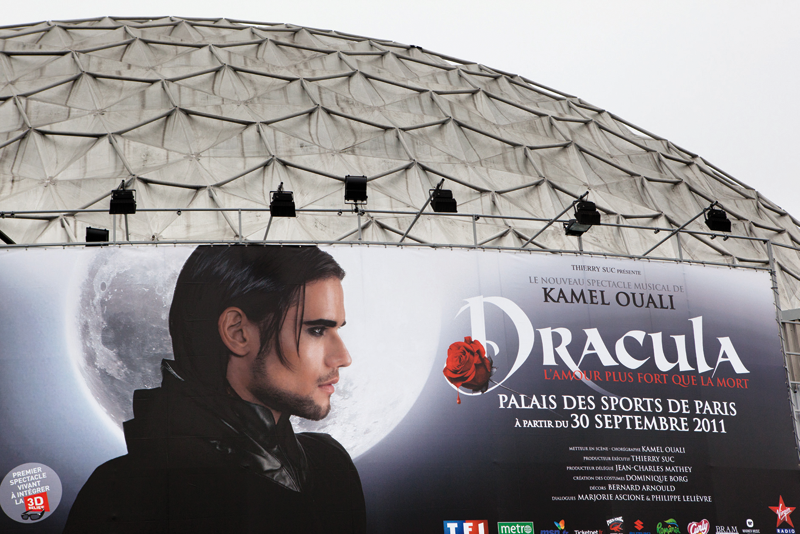This paper is available in Français too
Dracula opts for simplicity despite the modern and smart infrastructure, delivering clear vocals and concert sensations at a reasonable SPL. You will think this is normal, when the show’s producer is called Thierry Suc and that one Stéph Plisson is also involved, happy as a trumpet fish in a bath of sound.
We have to admit that for many years all we heard of Broadway was Michel Sardou’s La Java de Broadway. Subsequently the “musical” phenomenon hit France, but was soon steamrollered by Stage Entertainment, the distributor/producer of the world’s greatest successes. As a famous radio journalist would say, we have seen it all technically, from the profusion of small A/B [A1] enclosures with tailored analogue consoles upto the XLRs, to the simple V-DOSC range barely reinforced in the centre. The aim?? To proved both intelligibility in the playback and energy in the vocals. Let’s look together at Plisson’s proposal for this Dracula who is thirsty for sound.
A new exercise for Plisson
SLU : How far does your first “blood bath” go back?
Stéphane Plisson (front of house (FOH) engineer and audio designer) : We started the setup for Dracula on 20 August and rehearsals on the 29th 2011. Of course, the entire crew had been working for a long time on visuals or choreography. Sound rather came on top of the existing core than the other way around and the absence of a musical group on stage has made my job a little easier. Therefore I started by observing before making a number of technical choices.
SLU : Was it Thierry Suc who wanted you?
SP : We know each other well, which made things easier (laughter!!). He wanted a different type of rendering from what he had heard so far and what he was after could only be accomplished together. Nonetheless I initially rejected his offer since I feel there are Broadway specialists in France, and that this is another profession where not only song has to be considered, but also comedy. I shared my doubts with him as to my ability to make a success of it, just as I had told him for Mylène in Bercy or at the Stade de France, but he cut me off by saying “let’s go, but let’s go together”. The rest is history.
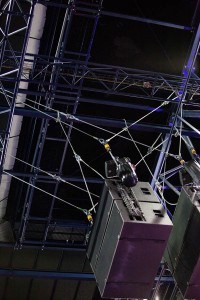
SLU : You had never worked on a Broadway show before Dracula?
SP : Worse yet, I had never even sat through a full show in the audience! The only time I got tickets with my wife, we left after a few minutes since we found ourselves on the side amid the sound equipment, heads in the subwoofers and she hates that (laughter!!) I didn’t come to listen to sound for that matter. I therefore tackled Dracula with zero experience and even a little mockery on the part of certain friends who view Broadway like a cushy routine. Slowly but surely I found my footing, thanks also to Kamel Ouali, who is a really nice guy, and to the entire crew who in some way helped me by taking me under their wing. It happened that I spent time sat in an easy chair watching them rehearse and wondering what to do next… I decided not to talk techniques. The theatre company existed well before the first speaker was rigged, it was therefore up to us to work on top in the most transparent way possible without making them waste time. My only request had been to work for two hours every morning with the performers to “create sound”.
Line array source multicasting!
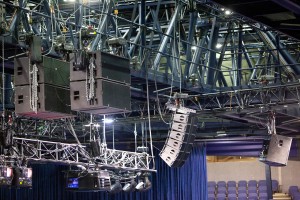
SLU : When did the idea of the sound system form in your head?
SP : Between April and May. The basic principle being that song and comedy are at the same sound level, I established my project by first thinking comedy and not the other way around. To do so I came up with a kind of sound bar, a little like the one found in Joe Bloggs’ lounge, by placing it above the stage framework and by playing on the phase of each cluster. This project was technically carried by Vlad (Vladimir Coulibre, system and sound engineer, compiler’s note). The problem is that it required lots of speakers and it is not necessarily adapted to this type of theatre, not to mention that financially it courts disaster (laughter!!) We would have been the first ones to use this configuration for this type of show, a major risk, but I know that it will be done one day…At the same time, whenever we can make progress, I’m interested. Then I excluded simple stereo with the help of two K1 arrays on either side of the stage, the opening was too large but I kept the planned KARA speakers to complete the kit by placing them everywhere. Since Bellote (Laurent Delenclos aka Bellote system and sound engineer, compiler’s note) had the same idea, as usual, he made it possible for me to implement my idea, which is no easy feat. And in the meantime we have even had further ideas for the placement of subwoofers (looks at Bellote from corner of eye).
SLU : What would you call this type of sound system?
SP : It’s nothing special. It’s simple multicasting but taking advantage of the small line source arrays whilst in the not so distant past it would have been done with 80 UPAs.
SLU : Do you know that abroad some people sell their concepts (laughter!) (pas sûr que concept dans le sens de conception technique puisse être traduit « concept » et laissé tel quel en anglais)
SP: Yes, I know, but it isn’t done in France, and it’s a shame since our goal and our role is to increase quality, which takes a lot of time. I would prefer not to adhere to the “it will do” principle, especially with the tools available today, which enable us to carry out our trade better and better.
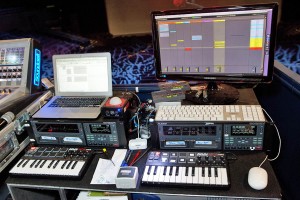
SLU : Why didn’t you use the usual speakers for musical comedies, the dV?
SP: Because in my opinion, the Kara has a better horizontal coerage and sound cohesion, a little like the K1, and then I like its low/mid contrary to the dV where it is much stiffer. Using these elements would have implied adding dV subs. You have to live with the times, there are 15 years between these two models. I could have worked with other brands of speakers offering the same colour as the Karas but to my knowledge they don’t exist. Thierry Suc is delighted with the result. It seems to correspond with what he had in mind. He is lucky to know what he wants to hear, this is not the case for me, but since he knows how to guide me towards what he wants, it just works between us!! (laughter!!) I do not claim to know where I’m going since most of the time I start from scratch. Sometimes in the studio I receive rough mixes, where faced with a result that is already attractive, you don’t know where to go. Then slowly but surely you dive in and you take the project elsewhere. It’s the same for Dracula. I injected my way of hearing things whilst keeping control of each performance and especially the vocals, which are never the same.
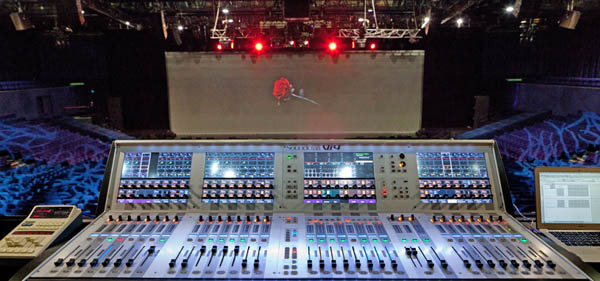
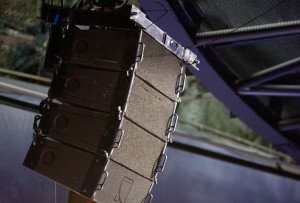
SLU : In terms of ”surround”, what did you plan?
SP : I want space, above all, and to do so I simply rigged two 4 dV clusters on the sides. I want to be able to open the image with the help of certain sounds. By listening to the album I detected a number of effects whose reversed reverberations on the voices that I kept in the theatre and injected into the laterals. I made sure nonetheless not to go overboard, since to me, the most beautiful effects are the ones you don’t hear. I often make use of a Lexicon 480 to set the mood. It has no equal today, and yet, believe me, I have tried everything.
SLU : Don’t you think that Dracula’s distributed sound system suits the Palais des Sports better than a simple pair of stereo arrays, even beyond musical comedies?
SP : Completely!! This theatre with a simple left/right is often a mess, it works but you don’t have the same quality of reception as what you have here. In multibroadcasting the theatre’s flaws are less enhanced, notably by not going into the cupola or else into the exits, which quickly generates afwul reverberation for a number of seats despite the fact that they have been clad with acoustic panels. There are also advertising panels that reappear and hit you on the head when you use the Dosc. (laughter!!)
…and the subwoofers rigged to the ceiling in cardioid mode!!
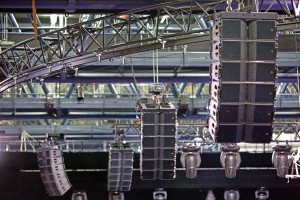
SLU : The setup of the subwoofers on the ceiling in three cardioid sets works well, but doesn’t it form an antenna nonetheless?
Bellote : (system and sound engineer): Everything can be optimised, even the installation of the Karas and their wedging. Something bothers me in the presets on the lower mid-range and..(explosion of laughter!!) The subwoofers as they are set up in two times three and in two sets of two times two prove to be directive. Even if it is very long and cardioid, this antenna is more directive than it should be. There is a solution. Without giving away too much, the ideal would have been to create a single central group between two catwalks with a delay to aim the lobe downwards. It would have been even more consistent in the theatre.
SP : You know what? It has to be tried! We will do it on Saturday between two performances, it’s our speciality (laughter!!)
SLU : Musically speaking, did you manage to get what you needed to work?
SP : Yes and no! The album not having sufficiently met with its audience, the artistic team that wrote and recorded it wasn’t around that much during the setup of the show. Consequently, in the beginning I only received orchestra playbacks and stems, which proved to be useless in the theatre since too compressed and mixed from a radio perspective. Listen (I admit it; in such a specific and analytic sound system as the one used for Dracula, their packed dynamic, their preaccentuation and the very choice of the levels of certain sounds compared to others, do not work, compiler’s note). I would have had to equalise and cut a lot to leave space for the voices, much too much, so I contacted Volodia, who have co-produced the album and I have all of the pieces on hard disk, which I was able to remix here, in the theatre on my Vi4.
The graph corner
The layout and cover of the subs

Sub Dracula at 30Hz: Here is an example of distribution at 30 Hz of the equivalent layout of the subs at the Palais des Sports thanks to Bellote. The least that can be said is that the antenna is not very directional and that the infra distribution is highly consistent around the three points made up of, from left to right, 6, 4 and 4 SB28s.

Sub Dracula at 63Hz:The same example of distribution but this time at 63 Hz of the layout equivalent to the subs at the Palais des Sports. The lobes are inevitably narrower but remain highly consistent and at this frequency, the Karas progressively come into play.
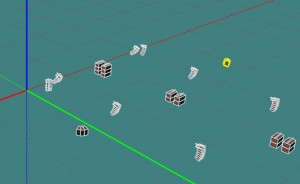
3D view top riggingThe kit rigged at the Palais des Sports: he only thing[A2] missing are the 6 UPJs installed in the stage bar facing the first rows.
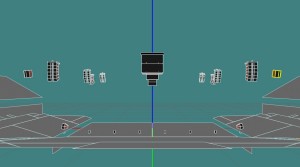
Vue 3D Face console: The entire kit at the Palais des Sports as seen from the console. The line of 6 UPJs installed in the stage bar facing the first rows, can also be distinguished. The only enclosures that were not installed in the end, are the four ones placed stage left and stage right.
Orchestra Playback on two Alesis HD24s
SLU : In terms of sources, what do you have available?
SP : In the beginning during rehearsals, I worked with two ProTools. Subsequently the team made the financial choice to transfer the tracks onto two Alesis HD24s, which led to the arrival of my partner-in-crime Jean-Philippe Schevingt to start up this configuration and the redundancy between the two machines. I keep one ProTools in the production department to be able to rework a title if necessary.
SLU : Are 24 tracks enough to hold all the PBOs and back-up vocals?
SP : We will talk later about chants sécu (backups ??), as to the PBOs I have approximately 16 tracks. In terms of sources to mix, I have 12 voices of which 7 singers. The singers play out the comedy but the reverse does not apply. Lastly we have an Ableton Live, which we have to send moods, sound effects and music that support comedy scenes with the help of two master Akai MPK mini keyboards, one being a back-up. The fact that it is a separate unit from the HD24 allows to give more latitude to the artists on the stage. The PBOs for each title are launched and stopped manually, the two readers work in perfect harmony. It is Greg Carlet who operates the machines. The novelty lies in the three Radial SW8, automatic switches, which each have two times eight analogue inputs for eight outputs and are here linked in sets of three to achieve 24 channels. Their role is to automatically switch between the signals from the HD24 as soon as one of them stops. To do so, all it takes is to record a continuous signal at 1kHz on track 1 or 24 of the two machines and as soon as one of them fails, the SW8 instantaneously switches to the other one. It is a genius tool that I have already used in the past and avoids any human intervention.
SLU : What about these back-up vocals…
SP : I may be wrong, but I assume that when I work with a singer, I have no back-up voice. If it involves a technical problem, I can fix it immediately with the live HF hand mics, ready to take over, I have one on the left of the and one on the right. If it’s a physical problem with one of the performers, I don’t see why I would make them sing since they have understudies, two males and one female. I have never knowingly replaced a live song by a playback and even less swapped a singer with their prerecorded voice with a simple click. I have a problem with it, I don’t assume. Towards the end of the rehearsals, since it bothered me and that in any case I would not have the time to set up these playbacks, I chose to discuss it with Kamel and the singers to inform them of my choice.
SLU : They must have been surprised…
SP : Yes, absolutely, but then they understood and recognised that it is more natural like this. Live performances have their dose of errors, it’s normal.
Voice processing
SLU : How do you process the voices?
SP : I made the choice to have only one sound for the comedy as for the vocals and an identical level. From there on I modulated my mix by entering all that is hard or that represents a problem. To me sound has to be deep and broad. Working loudly and harshly, balancing in mono and with distortion, all that does not “rock” for me, it’s just bad. That is what I think and I take responsibility for it. I was fortunate enough to have worked for a long time with la Mano Negra and they understood that playing loudly did not mean producing a good sound. The best rock groups are not those who are the loudest on stage, contrary to preconceived notions. You have a good sound when you have the impact there where it needs to be, the sound of the guitar as it should be …
SLU : And what about our voices then (laughter!)
SP : Always the Waves Multirack where I chain a C4, a Renaissance DeEsser, and a CLA-76 at the very end. The CLA-76 that emulates the classic 1176 is specific to this show and suits the DPA 4088 headband microphone. My problem is the distance between mouth and mike, distance that does not change when the singer goes high and tackles the notes in full voice more in the nose than in the belly. If he had a handheld microphone, he would obviously move it away. The small cell on the 4088 doesn’t react well. I tidied up a little with the C4 but trying not to remove what is natural from the sound colour of the voices. Perhaps my choice of microphone is no good. The DPA omni would sound better but at the expense of theatre constraints that are not very manageable.
SLU : You really treat vocals and comedy no differently?
SP : Barely, I simply route all the voices into a group that I activate at the end of each song and that is very compressed in order not to have too much of a dynamic gap between actors. Whether there is one person on stage or 12, we are consistent. I also take advantage to cut a little off the low register and shave off a little of the extreme high notes that stand out too much, high notes in the 10/12 kHz range that doesn’t exist in real life. The difference I make with the effects that I stress in the beginning of the scene and quickly reduce in order not to drown and damage the comprehension of the words. Sometimes I bring a little “Disney” note that I like to certain selections and I believe that if I do another musical after Dracula, I would go even further in terms of moods.
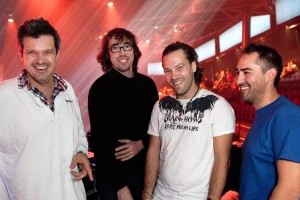
SLU : But then you did end up liking musical comedy, are you getting ready to settle down by any chance? (laughter!!)
SP : Ah no, no, no!! I like the road, musicians and live performances, but with Dracula it’s interesting since I’m living a different experience that may be useful for other similar projects. I hope to have contributed a little to the Broadway shows. We shall see. Only the audience can tell since at my level I’m not aware of it. Regardless, should I work again in this area, I would request to contribute to the music in advance in order to benefit from the best possible sources. Ideally one should think “performance” when one creates and records songs, without which they lack harmony with the show. The album and show crews must work as a team.
SLU : Go on, you are therefore ready to work on another musical!
SP : Yes, as long as a new story is recreated from scratch, a new challenge. What I also like is the theatre company. I’m a huge fan of the circus and I find the same spirit here that I love. They are all adorable here. Something different and stronger is happening than with four musicians and a singer. This team spirit is found among technicians on tour, less often with the performers. One exception is Marc Lavoine. He is a deeply human chap, with a beautiful voice, who trusts you and gives you carte blanche all the time. I have lived a magical experience, a true encounter with a passionate and fascinating guy and yet we’ve known each other for six years and we have just scheduled 210 dates!!
CONCLUSION
First one regret, for not having been able to listen to such a system with sources worthy of the name. Stéphane’s and some compositions’ talent are not enough, the quality of the acoustics and arrangements of the playbacks is unequal to say the least, sometimes insufficient. Despite this and while staying at approximately 95dB(A), the pressure seems stronger and thrills the audience with a special mention for classical selections. Yvan Cassar was able to weave a dense and rich classic web, allowing the sound system to shine, which is all its wants. Even the recurring problem of the gap in the impact between the subs and the small woofers in the compact line arrays such as the Kara and its two small 8 inches is absorbed, resulting in a natural sound and very nice spectral riches with strings truer than nature. The coverage provided by the eight clusters of six Kara is nearly perfect and not a single member of the audience is forgotten. Intelligibility is not criticised. The short distance with the speakers and their surgical precision provide true comfort by practically annihilating any theatre flaws. We almost wonder about the usefulness of A/B system or the installation of dozens of loudspeakers in all corners… Only the presence of two clusters of three Meyer JM-1Ps, one on each side to open up the outer tiers, surprises, by the more straightforward and aggressive way of projecting the top of the spectrum and the slightly harder texture of their upper mid-range. A few last Karas would be so good!! The first rows are not forgotten thanks to six UPJs cleverly hidden by an acoustic fabric. Hats off also to the distribution of the low register and sub-bass. The three rows of subs work well and add a little muscle to the 48 Kara in a very natural way. A few wind noises on the DPA 4088 have quickly been suppressed by closer cut-offs. The only drawback is that it tends to weaken the already dry and crystal-clear rendering of these good mikes that ideally reproduce spoken passages but not quite as good sung passages where the foundation of a “large diaphragm” mike is lacking on certain voices. Very nice “Concert” contribution by Stéphane Plisson with his delightful fondness for controlled voices, a full low register and events emphasizing such and such an instrument or comedy passage by playing with the two arrays of four dVs used as “spreaders”. The consistency demanded between spoken and sung passages is real and fills the gap typically felt in Broadway shows between these two phases. Lastly, hats off to Stéphane to be able to mix everything at the top on an extremely resonant floor on the control room, acting as a membrane at the bottom. The desire to cut in this mess would represent a trap for many, me being among the first!!



